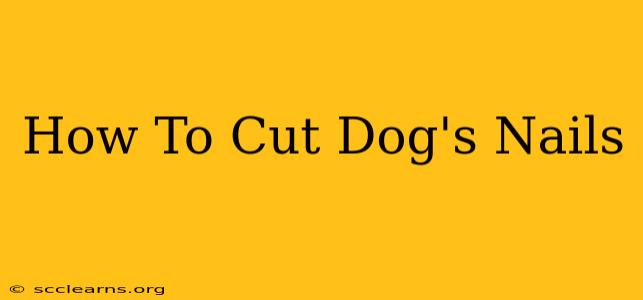Clipping your dog's nails might seem daunting, but with the right technique and a little patience, it can become a manageable part of your dog's grooming routine. This guide will walk you through the process step-by-step, helping you avoid those dreaded yelps and ensure a safe and comfortable experience for both you and your furry friend.
Preparing for the Nail Trim: Gathering Your Supplies
Before you begin, gather the necessary supplies. This will help streamline the process and ensure you have everything you need within easy reach. You'll need:
- Dog nail clippers: There are several types available, including guillotine clippers and scissor clippers. Choose the type you're most comfortable using. Guillotine clippers are generally preferred for smaller dogs, while scissor clippers might be better for larger breeds with thicker nails.
- Styptic powder or pencil: This is crucial for stopping any bleeding that might occur if you accidentally cut the quick (the pink part of the nail containing nerves and blood vessels).
- Treats: Positive reinforcement is key! Use high-value treats your dog loves to reward calm behavior and cooperation.
- Towel: This can help restrain your dog if needed, especially if they're nervous or wriggly.
Assessing Your Dog's Nails: Identifying the Quick
The quick is the pink part of the nail that contains nerves and blood vessels. Cutting into the quick is painful for your dog and will cause bleeding. Before you start clipping, carefully examine your dog's nails to identify the quick. In light-colored nails, the quick is easily visible. In dark-colored nails, it's harder to see, so it's best to err on the side of caution and cut less.
Tip: If you're unsure where the quick is, it's best to consult a veterinarian or professional groomer for the first few nail trims. They can show you how to safely identify the quick on your dog's nails.
The Nail Trimming Process: Step-by-Step
Now, let's get to the actual trimming:
-
Get your dog comfortable: Start by making your dog comfortable. Let them sniff the clippers and give them plenty of treats. A calm and relaxed dog will be much easier to handle.
-
Hold the paw firmly but gently: Hold your dog's paw firmly but gently, ensuring they don't feel trapped or stressed. Many dogs tolerate this better if you gently massage their paw before attempting to trim the nails.
-
Trim in small increments: Never cut the nail in one go. Trim a small piece at a time. It’s better to trim a little at a time and make several cuts than to risk cutting the quick.
-
Check your work: Regularly check if you are getting too close to the quick, especially if your dog has dark nails.
-
Reward with treats: After each successful nail trim, praise your dog and give them a treat. Positive reinforcement is key to making this a positive experience for them.
-
Handle potential bleeding: If you accidentally cut the quick, apply styptic powder or pencil immediately to stop the bleeding. If the bleeding is profuse, consult a veterinarian.
Frequency of Nail Trims: Maintaining Healthy Paws
How often you need to trim your dog's nails depends on your dog's breed, activity level, and the type of surface they walk on. Generally, you should trim your dog's nails every 2 to 4 weeks, but you may need to do it more frequently depending on their growth rate. Regularly checking their nails is a good habit to prevent them from becoming overgrown.
Beyond Trimming: Recognizing Signs of Nail Problems
Overgrown nails can lead to various problems, including discomfort, lameness, and even joint issues. Be on the lookout for:
- Clicking sounds: Overgrown nails can click on hard surfaces.
- Difficulty walking: If your dog is limping or seems hesitant to walk, their nails might be causing discomfort.
- Deformed nails: Look for any signs of deformity or infection.
If you notice any of these signs, consult your veterinarian or groomer immediately.
By following these steps and maintaining a calm and patient approach, nail trimming can become a simple and stress-free part of your dog's care routine. Remember, consistency is key – regular nail trims will help your dog stay comfortable and healthy.

